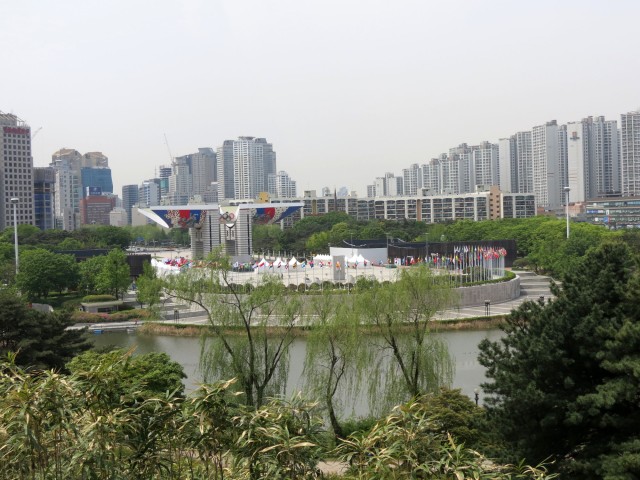

In 1988, twenty eight years ago, Seoul hosted the summer Olympics, a first for South Korea. Right now, Rio de Janeiro is hosting the summer Olympics, a first for Brazil (and South America).
Every Olympic city-host constructs stadiums, parks and other buildings for the games, for all the competitors and all the visitors. Seoul was no exception, as they were really proud hosts.
The Seoul Olympic Park was created in preparation for the 1988 Games, although large parts of it existed already, and many sports and music festivals are still held in the 6 stadiums dotted around the edge of the park. Many Seoul residents come here to relax and unwind regularly, and on the day we were there we saw many groups of city workers walking during their lunch break.
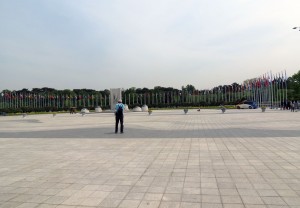

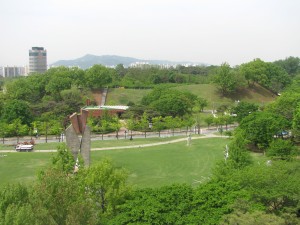
The Olympic Park, in the area of Songpa, south of the Han River, is a very large, green park with wilderness areas, lakes, a musical fountain, trails, bridges, wild flower garden, rose garden, and museums (Mongchon, SOMA Museum of Art, Baekje Museum, Olympic Museum). A massive 1.6-mile Baekje-dynasty earth fortification, called Mongchontoseong, built in the 3rd century AD, runs through the north part of the park and the Mongchon Museum has artifacts from the Baekje kings (more on all those later). On the east and south east side are attractions built for the Olympics: a swimming pool, tennis courts, three gymnasiums, and the velodrome. Outside the park is the enormous Olympic apartment complex.


 The main entrance to the park is across an expansive plaza, called Peace Square, which leads to the World Peace Gate, which definitely qualifies as one of the Olympic statues/sculptures/structures. Beyond the World Peace Gate is the Flag Plaza, still flying the flags of the nations that attended the 1988 Olympics (South Africa was not one of them due to sanctions in place because of Apartheid). The plaza is ringed with fast food outlets, coffee shops, a convenience store, kiosks to rent bikes etc.
The main entrance to the park is across an expansive plaza, called Peace Square, which leads to the World Peace Gate, which definitely qualifies as one of the Olympic statues/sculptures/structures. Beyond the World Peace Gate is the Flag Plaza, still flying the flags of the nations that attended the 1988 Olympics (South Africa was not one of them due to sanctions in place because of Apartheid). The plaza is ringed with fast food outlets, coffee shops, a convenience store, kiosks to rent bikes etc.


Over 200 sculptures are scattered on the sprawling lawns in the south part of the park, close to the SOMA Museum and Baekje Museum. They were designed and made by sculptors from around the world, and are a great way of showcasing many different ideas. It’s fun to just stroll, looking at the sculptures, admiring some and being perplexed about others. Many people also like to have a picnic near the sculptures. This also became a popular location for movie and commercial TV filming.
To get there: Take subway Line 2 (green) to Jamsil, and change to Line 8 (pink) and go to Mongchontoseong. Follow the exit 1 to Mongchontoseong Fortress/Peace Gate. The park is open 6am-10pm daily.
 About the sculptures and special structures:
About the sculptures and special structures:
Here I will talk about the World Peace Gate and the pillar masks.
First, the stunning colorful World Peace Gate, started on December 31, 1986 and completed on August 31, 1988. This is the work of architect Kim Chung-up, who designed it to celebrate the spirit of the Seoul Olympic Games—peace and harmony—and also to symbolize the ability of the Korean people. This was the last work of the famous Korean architect (1922-May 1988). The steel-reinforced concrete structure beckons as soon as you exit the subway station—the pillars stand with “wings” that look like bird wings or outstretched arms, welcoming.


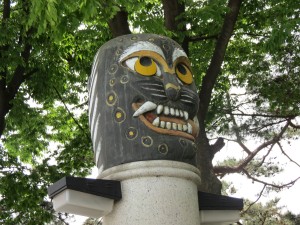
On the edge of the plaza, leading to the Gate, are 30 line pillar masks made by sculptor Seung-Taek Lee, a famous Korean interdisciplinary artist, born 1932. The bronze masks are mounted on stone pillars 3m/9ft 10inches high, which are also lamp posts, and are also meant to welcome people to the Gate. Most of them are interesting double-faces, some looking almost like the totem poles I spoke of earlier (see here https://vivskoreanadventures.wordpress.com/2016/08/07/totem-poles-in-korea/ )

The mural on the underside of the roof wings of the World Peace Gate is called “A Painting of Four Spirits”. Blue and red are used to symbolize Um and Yang, which is an oriental symbol of the universe and creativity.
Four spirits guard the gate. A red phoenix guards the south, a black turtle guards the north, a white tiger guards the west, and a blue dragon guards the east. The spirits are depicted as ascending towards heaven and signify the strength of Koreans and their freedom.
An eternal flame is underneath the gate, as well as a declaration of peace calling for world
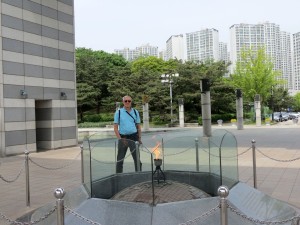
harmony and happiness for all citizens of the world, regardless of ideology, race, or religion. The Korean people are very proud of this gate. And quite rightly so.
In the following post I will showcase some of the other sculptures.
